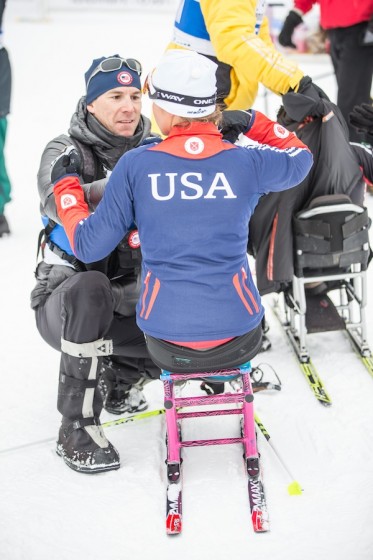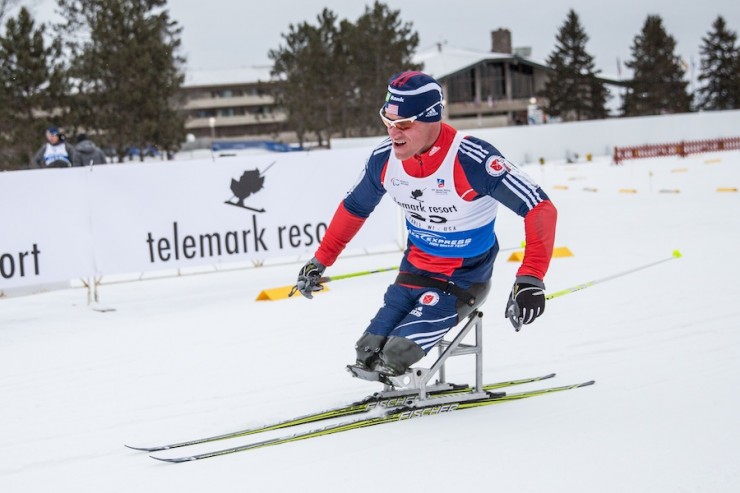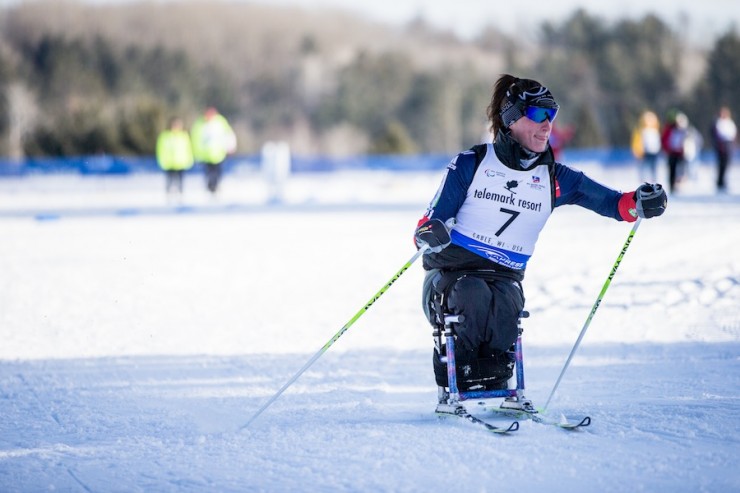
At the 2010 Winter Paralympic Games in Vancouver, B.C., the U.S. finished fifth in the overall medal count. A dominant performance by the U.S. alpine team resulted 11 medals, three of them gold.
Meanwhile, the U.S. Olympic nordic team, including biathlon, consisted of just six athletes and a handful of coaches and support staff. Albeit small, the team was not without success. Andy Soule, an Afghanistan war veteran and double above-the-knee amputee, made history by becoming the first American to medal in biathlon in either Paralympic or Olympic competition.
At the 2014 Paralympics in Sochi, Russia, nordic skiing and biathlon will account more that half of the available medals. To improve overall team results, the U.S. Olympic Committee realized that the U.S. needed more focus on these sports.
In 2011, John Farra, an Olympic cross-country skier and then-U.S. Ski and Snowboard Association (USSA) nordic director, was the man selected as the first high-performance director of the U.S. Paralympics Nordic Program. Today, he leads a team of coaches and staff responsible for building a world-class program.

In a recent phone interview, Farra cited growth in the sport as evidence that the U.S. is on its way to that goal. At the Sochi Paralympics in March, Farra will field a team of 19 athletes, four coaches and 13 support staff. The Russians will max out at the allotted team size of 30 athletes, a goal that Farra has set for his team size for 2018 Winter Games in Pyeongchang, South Korea.
Assessing the team’s prospects for Sochi, Farra said, “On the men’s side, we have three guys who, on any given day, can be somewhere in the top six in the world.”
In a test event in Sochi last March, Dan Cnossen, Soule and Sean Halsted finished fourth, fifth and sixth, respectively. One of the newest and most promising men on the national team, Farra described Cnossen as “a really tough guy who trains unbelievably professionally and really puts everything towards it.”
“While we are not expected to win any medals, when we are that close we are spending a lot of time and effort to find that extra half percent or 1 percent,” Farra said. “That gets them into the top three to steal a medal from the Russians or the Ukrainians.”
On the women’s side, Farra saw potential when he spoke with Tatyana McFadden a year and a half ago. A world-class wheelchair racer with nine gold medals between several Paralympics and World Championships, McFadden expressed interest in competitive nordic skiing. On Nov. 3, the 24-year-old University of Illinois student completed an unprecedented marathon “Grand Slam,” winning the Boston, Chicago, London, and New York road marathons in a single year.
- Dan Cnossen (Sit ski; Navy)
- Sean Halsted (Sit ski; ret., Air Force)
- Andy Soule (Sit ski; ret., Army)
- Jeremy Wagner (Sit ski; ret., Army reserves)
- Aaron Pike (Sit ski,;Univ. of Illinois Champaign)
- Tatyana McFadden (Sit ski; Civ, Univ. of Illinois Champaign)
Development Team (Emerging & Military)
- Eric Frazier (Sit ski; ret., Marines, Team Semper Fi)
- Travis Dodson (Sit ski – ret., Marines, Univ. of Illinois Champaign)
- Augusto Perez (Sit ski)
- Kevin Burton (Visually impaired; ret., Navy)
- Omar Bermejo (Standing; ret., Marines)
- Jake Adicoff (Visually impaired)
- Oksana Masters (Sit ski)
- Beth Requist (Sit ski)
A multiple ESPY Award (ESPN) nominee, McFadden’s celebrity status is steadily rising, and she was twice featured on the NBC Nightly News for her New York City win. Her sponsor, British Petroleum featured her in its TV promotional spots, and in other positive news, NBC announced it will provide a landmark 100 hours of television coverage for the Winter Paralympics.
“Next year when the Games are on you’ll be seeing national TV spots featuring Tatyana McFadden sit skiing and Olympian Kikkan Randall skiing,” Farra said.
Adding to McFadden’s media appeal is her storyline of returning to Russia to where she was born with spina bifida, a birth defect in which bones fails to form properly around the spinal cord. Abandoned in a Russian orphanage, she was adopted by Deborah McFadden and brought to the U.S. at age 6. Since 2012, Tatyana has actively advocated against a Russian law that prevents Americans from adopting Russian children.
“We hope she continues to have a good experience [with skiing] and that will drive some interest to our sport,” Farra said. “She has more fans than we’ll ever have, but our job is to not let it become a distraction and to prepare her with the technical skills to get around the course. She’s a good gal and it’s really fun to have her on the team.”
On McFadden’s chances for a medal in Sochi, Farra said, “Who knows? She is super strong and unbelievably fit. She has the most important part of nordic skiing down which is the fitness, and that’s impossible to fake. Technical skills will be an issue for her because her racing wheelchair doesn’t slide around corners and have the potential of going off the course and crashing into trees. It would be a huge challenge for anyone to go from newbie to Paralympic athlete in such a short period of time.”
McFadden first demonstrated her potential by winning the sprint race at last year’s U.S. Adaptive Cross Country Championships at Soldier Hollow last year in a borrowed and somewhat ill-fitting sit ski. After, Farra contacted a Japanese company that makes sit skis designed to accommodate McFadden’s more forward-leaning position in wheelchair racing.
“As soon as she slipped in there, and I mean slipped in there because it’s a tight fit, she got this big smile on her face,” he said. “We’ll see how it works out because her first race in it will be at the IPC [International Paralympic Committee] World Cup races in Canmore in December.”

In addition to finalizing the team at World Cup and National Championship races this season, Farra’s strategy is to use these races to get his staff ready for Sochi.
“We plan to bring a large team and the entire Sochi staff to Canmore [in December] because we’ve had a huge transition from being a country that shows up with only a few athletes,” he said of the early season World Cups. “We need to make sure we protect the chances of our top athletes to steal a medal and give the appropriate level of service to those developing athletes who are experiencing their first Paralympics. We’re looking forward to getting all those things dialed in.”
Nationals are held alongside the able-bodied U.S. Cross Country Championships at Soldier Hollow in January, followed by World Cup races in Oberstdorf, Germany.
In October, national-team coach James Upham accompanied four sit-skiers – Cnossen, Soule, Halsted, and Oksana Masters – at a U.S. Paralympics Nordic camp in Oberhof, Germany. It was the team’s first training camp in the ski tunnel there.
According to Farra, they’ll take six or seven athletes to Oberstdorf for the World Cup races from January 16-19.
“We’re going to bring a small elite group … who we feel need to be there to dial in their chances of winning medals in Sochi,” Farra said. “After Germany the team will hole up in Winter Park Colorado which will be good in terms of an altitude strategy. After that, we’ll head to Italy a week before the games and stay at a beautiful five-star resort on the top of a mountain with ski in ski out and a biathlon range, to relax a bit and get used to the time change before flying to Sochi.
“And that’s it,” he added. “We’ll be there and then we’ll be back here in March after we win a bunch of medals. Then we’ll come home and hang them up and enjoy them!”
***
About the Author:
FasterSkier’s Para-Nordic contributor, Mark Vosburgh lives in Missoula, Mont., where he works as a Wildfire Scientist for the US Forest Service. In addition to being a chemical engineer, Mark is a cross -country and backcountry skier, bluegrass musician, and biker. He’s also a freelance writer for numerous publications, including 48 Degrees North and MakeitMissoula.com.
Mark Vosburgh
FasterSkier’s Para-Nordic contributor, Mark Vosburgh lives in Missoula, Mont., where he works as a Wildfire Scientist for the US Forest Service. In addition to being a chemical engineer, Mark is a cross-country and backcountry skier, bluegrass musician, and biker. He’s also a freelance writer for numerous publications including for 48 Degrees North and MakeitMissoula.com.



